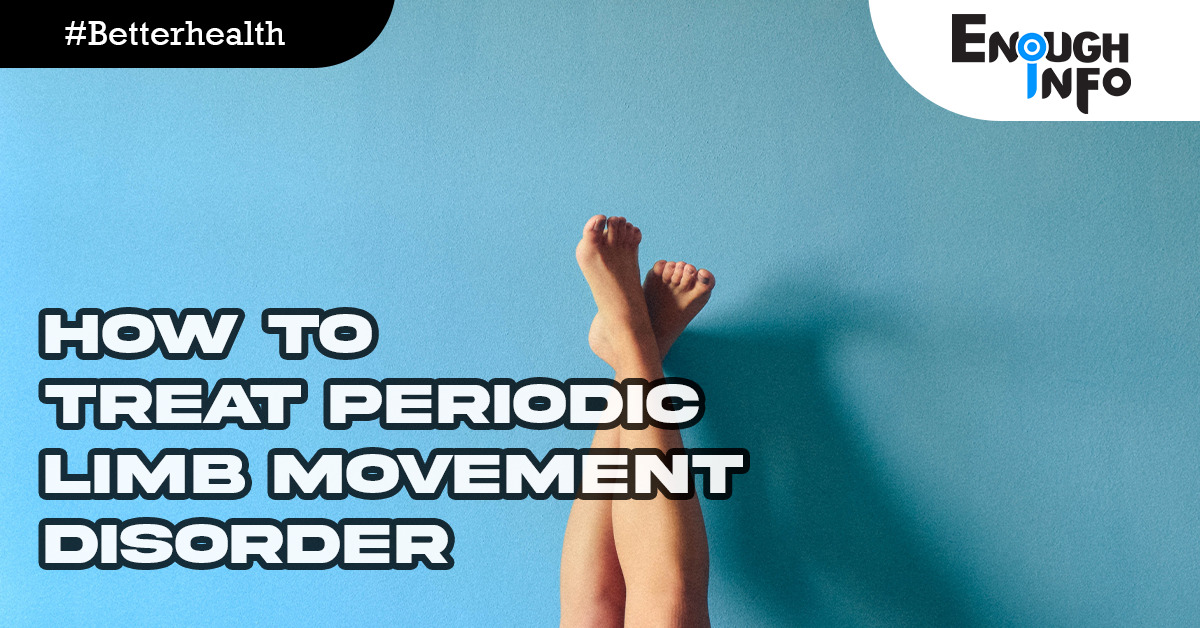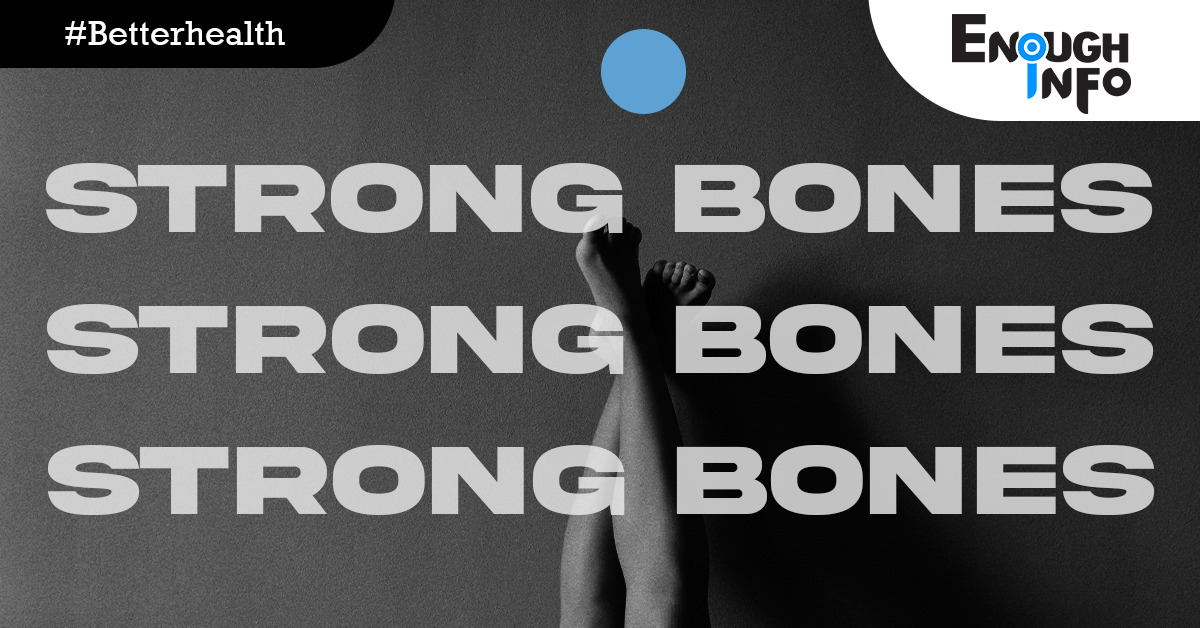How To Treat Periodic Limb Movement Disorder

How To Treat Periodic Limb Movement Disorder: Periodic, repetitive movements of the legs and feet as you sleep are signs of the uncommon sleep problem known as periodic limb movement disorder (PLMD). EnoughInfo.com

The condition might occasionally also affect the arms. These movements may be identified as transient muscle twitches, jerking motions, or an upward flexing of the feet if you have PLMD or sleep with someone who has PLMD. PLMD can cause sleep disruption and co-occur with other sleep disorders, such as narcolepsy and restless legs syndrome.
FAQs & Answers on How To Treat Periodic Limb Movement Disorder
1. Is PLMD curable?
PLMD is not curable, but it can be effectively managed with treatment. In some cases, the symptoms may go away on their own, but most people with PLMD require long-term management. Health Benefits Of Turmeric
2. Can Periodic Limb Movement be prevented?
There is no known way to prevent PLMD, but some lifestyle changes may help reduce the risk of developing the disorder. These include maintaining a regular sleep schedule, avoiding caffeine and alcohol, and practicing good sleep hygiene.
3. What triggers PLMD?
Dopamine insufficiency or improper nerve transmission throughout the spinal cord are two potential causes. In instances of secondary PLMD, the following factors may be to blame: Diabetes. lack in iron. using caffeine. Health Benefits Of Garlic
What is Periodic Limb Movement Disorder (PLMD)?
A sleep problem known as periodic limb movement disorder, or PLMD, impacts 4% to 11% of the population. During sleep, those who have PLMD frequently jerk, cramp, or twitch their lower limbs. These periodic limb movements (PLMS), which can last up to an hour, occur every 5 to 90 seconds. Even if they don’t wake up, the motions disturb the person’s sleep, which leads to daytime sleepiness and weariness.
Read Also: How to Build Healthy Bones (Top Strategies: 2023)
The affected person might not be aware that they have a sleep problem because the movements take place while they are asleep. They’ll observe signs like extreme daytime fatigue and nighttime awakenings for no apparent reason. They could think they have sleeplessness as a result. It is more typical for a sleep companion to observe the movements and bring them up to the person who is experiencing them. How To Be A Man
PLMD can happen to anyone at any age, however it is extremely uncommon in youngsters. Comorbid sleep apnea, a neuropsychiatric condition, and having a parent with RLS can all raise a child’s risk. Age considerably raises the risk for PLMD, and up to 45% of older persons show symptoms. Both men and women are impacted by PLMD.
What causes Periodic Limb Movement Disorder?
PLMD can be classified as a primary or secondary disorder, depending on whether it develops on its own or as a result of another illness. In the instance of primary PLMD, researchers are still unsure of the condition’s aetiology. Dopamine insufficiency or improper nerve transmission throughout the spinal cord are two potential causes.How to Prevent Osteoporosis from Getting Worse
In instances of secondary PLMD, the following factors may be to blame:
- Diabetes
- Iron deficiency
- using caffeine
- tumour or spinal cord injury
- Uremia
- Anemia Director Of Engineering Job Description
- Other sleep disorders include sleep apnea, narcolepsy, restless leg syndrome (RLS), and REM sleep behaviour disorder.
- Willam’s syndrome and other neurodevelopmental disorders, such as attention deficit hyperactivity disorder (ADHD),
- Side effects of some medications, such as lithium, neuroleptics, antiemetics, and tricyclic antidepressants
- withdrawal from sedative drugs, such as benzodiazepines and barbiturates
While PLMD can co-occur with other sleep disorders, RLS is the one with which it does so most frequently. PLMD affects 80 to 90 percent of individuals with RLS.
Read Also: What is Arthritis and How to Prevent it( A Good Guide)
PLMD and RLS share symptoms that affect the legs, but they are not the same disorder, and they are diagnosed and treated differently. While PLMS happens while the individual is sleeping, RLS symptoms appear while the person is still awake. There are also variations in the physical experiences. RLS is characterised by unpleasant tingling or crawling feelings in the legs and an uncontrolled impulse to move the legs to feel better. Legs with PLMD constantly jerk or twitch, frequently without the patient’s knowledge.
Do you know how PLMD is Diagnosed?
A person may go for a while without receiving a PLMD diagnosis. The effect on their quality of sleep could not even be noticeable. As a matter of fact, the movements are more likely to cause their sleeping spouse to have sleep interruptions. When other symptoms, such as daytime drowsiness or exhaustion, start to affect a person’s daily functioning and wellbeing, or when their sleep partner recognises the symptoms, people frequently seek treatment. How To Get Rid Of Fruit Flies (Step by Step)
Speak with your physician if you believe that you or your bed partner may have PLMD. They will probe you during your session to learn more about your sleep problems and ascertain whether they might be a result of a comorbid condition like diabetes or iron shortage. They might look into your past medical history, that of your family, any drugs you are now on, as well as your current sleep and lifestyle patterns. To rule out a different ailment, your doctor might request a sample of your blood or urine or prescribe more testing. 5 Best Ways To Reheat Steak( A Complete Guide )
Your doctor may recommend you see a sleep specialist if your sleep partner reports that you are moving your legs during the night and your doctor suspects PLMD or another sleep disorder. An nightly sleep study, also referred to as a polysomnogram, may be requested from a sleep specialist. Your vital signs, including your leg movements and breathing, will be watched while you sleep in order to rule out sleep apnea. You may be given a diagnosis of PLMD if the leg movements happen at least 15 times per hour.
How To Treat Periodic Limb Movement Disorder
Periodic Limb Movement Disorder (PLMD) is a sleep disorder that is characterized by involuntary movements of the legs or arms during sleep. This condition can lead to disrupted sleep, daytime sleepiness, and other problems. Fortunately, there are several treatment options available that can help manage the symptoms of PLMD. In this answer, we’ll discuss long-detailed ways on how to treat Periodic Limb Movement Disorder. Director Of Engineering Job Description

Read Also: How Does Rheumatoid Arthritis Affect The Heart And Lungs?
Medications
Medications can help manage the symptoms of PLMD by reducing the frequency and intensity of limb movements during sleep. Some medications that may be prescribed for PLMD include:
- Dopamine agonists: Dopamine agonists are drugs that mimic the effects of dopamine, a neurotransmitter that plays a role in movement control. These drugs can help reduce the frequency and intensity of limb movements in PLMD. Examples of dopamine agonists include pramipexole, ropinirole, and rotigotine.
- Benzodiazepines: Benzodiazepines are a type of sedative that can help reduce limb movements during sleep. They are typically prescribed in low doses and may be used in combination with other medications. Examples of benzodiazepines used for PLMD include clonazepam and diazepam. How To Be Friends With A Girl That Rejected You
- Anticonvulsants: Some anticonvulsant medications, such as gabapentin and pregabalin, have been found to be effective in reducing limb movements during sleep. QA Engineer Job Description
Lifestyle Changes:
Making some lifestyle changes can also help manage the symptoms of PLMD. Here are some tips:
- Regular Exercise: Regular exercise can help improve sleep quality and reduce the frequency and intensity of limb movements during sleep. However, it’s important to avoid exercising too close to bedtime, as this can have the opposite effect and make it more difficult to fall asleep. 150+ Wedding Anniversary Wishes And Messages
- Good Sleep Habits: Practicing good sleep hygiene, such as sticking to a regular sleep schedule and avoiding caffeine and alcohol, can help improve the quality of your sleep and reduce the symptoms of PLMD.
- Stress Management: Stress can exacerbate the symptoms of PLMD, so finding ways to manage stress, such as meditation or yoga, can be helpful.How To Deal With Stress(Guide2023)
- Behavioral Therapies: Behavioral therapies can also be helpful in managing the symptoms of PLMD. Here are some examples: How To Stop Feeling Insecure About Your Body
- Cognitive Behavioral Therapy for Insomnia (CBT-I): CBT-I is a type of therapy that focuses on changing negative thoughts and behaviors that may be contributing to insomnia. This therapy has been found to be effective in reducing the symptoms of PLMD.
- Biofeedback: Biofeedback is a technique that involves using sensors to monitor your body’s responses and providing feedback that can help you learn to control those responses. It has been found to be effective in reducing limb movements during sleep in some people with PLMD.
- Progressive Muscle Relaxation: Progressive muscle relaxation is a technique that involves tensing and then relaxing different muscle groups in the body. This can help reduce muscle tension and improve sleep quality.
Read Also: How To Be A Successful Entrepreneur (The Ultimate Guide)
Conclusion
Periodic Limb Movement Disorder (PLMD) can be treated through a combination of medications, lifestyle changes, and behavioral therapies. Medications such as dopamine agonists, benzodiazepines, and anticonvulsants can help manage the symptoms. Lifestyle changes such as regular exercise, good sleep habits, and stress management can also be helpful. Behavioral therapies such as Cognitive Behavioral Therapy for Insomnia (CBT-I), biofeedback, and progressive muscle relaxation can also be effective. It’s important to work with your doctor to find the right combination of treatments for your individual needs. How To Get Rid Of Rust (8 Good Methods)
Recommended;
What is Arthritis and How to Prevent it( A Good Guide)
How To Deal With Stress(Guide2023)
How to Build Healthy Bones (Top Strategies: 2023)




